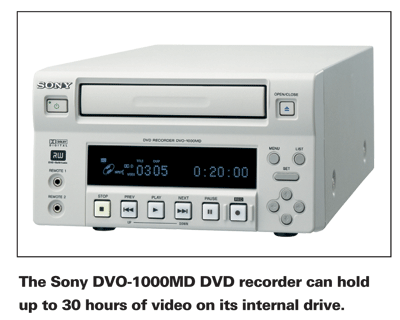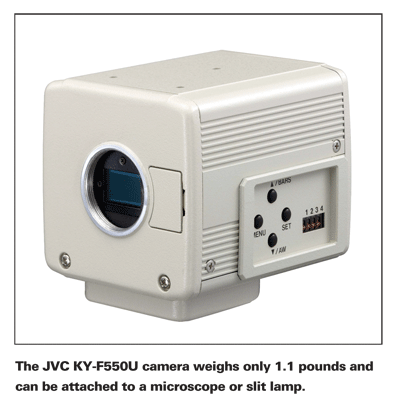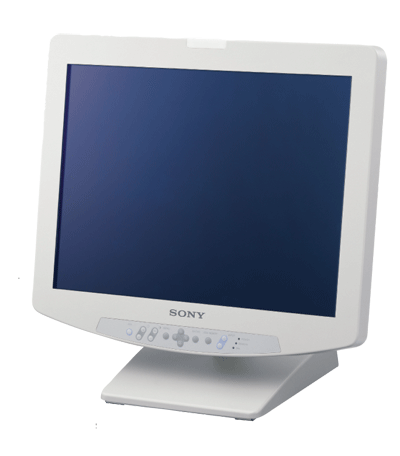Each year, events such as the American Society of Cataract and Refractive Surgery's film festival highlight the innovation that exists in the world of ophthalmology. Part of bringing these new concepts to audiences is the quality of the recording equipment surgeons use. In this article, we'll take a look at some of the latest cameras, recorders and monitors for managing video in your practice.
• Sony DXC-C33 camera. This small camera allows surgeons to record cases but not have to devote a lot of space to their recording equipment. Sony's Brian Zimmer, marketing manager for surgery products, says the camera's size makes it ideal for attaching to the surgical microscope. It also features a full digital connection, called the iLink (Sony's version of FireWire) to a recording deck without any loss in quality. "This is a unique feature, since most analog cameras can only send out analog signals," says Mr. Zimmer.
Cincinnati
• JVC KY-F550U camera. This camera weighs only 1.1 pounds and, with an adapter, can be mounted on microscope, slit lamp or operating microscope. It also has a FireWire-like interface that permits full digital transfer of your case to recording equipment without loss of data. JVC says the camera uses 12-bit analog/digital conversion and 24-bit digital signal processing that ensure a highly stable image without the loss of fine details and provide very good overall picture quality. The camera comes bundled with PC software that allows you to view the video live on a computer as you control the camera's functions. It costs $3,450.
• Sony DVO-1000MD DVD recorder. When it comes time to save your work for posterity, you can run a camera to this recording deck to record up to 30 hours of video on the device's 80 GB hard drive. The footage can then be burned to a DVD for replaying on another DVD player in the office or at a presentation. Mr. Zimmer says this recorder features recording with no need for finalization, a computer process that can make burning discs time-consuming. "With some DVD recorders, the disc has to be formatted before the final recording can be made," he says. "These systems can sometimes take up to eight minutes to take the data and put it in a readable format on the disc. Because the DVO uses Sony DVD media that are pre-formatted, there's no finalization required." The DVD+RW discs can also be re-written over many times.
The DVO-1000 also allows the physician to overlay patient data, such as name, ID number, any descriptive text, etc., over the video. This is accomplished using buttons on the front of the recorder. However, Mr. Zimmer says if you're going to be typing in data often, it can be cumbersome to use the basic buttons on the unit. "We developed the 'DVOKEYBOARD' as an optional accessory specifically for users who want to add patient data on a regular basis, since this QWERTY keyboard makes it much easier to do," he says. "The keyboard is in a completely sealed water-resistant rubber casing so it can be easily washed down—making it ideal for use in an OR. It also has dedicated keys to control the DVO-1000MD functions. Up to 13 pages of text can be added per patient and can be viewed on-screen." The keyboard costs $469.
"I record every surgery, all pre- and postoperative findings, and frequently edit for lectures and video productions using the DVO," says Dr. Osher. "The Video Journal uses both DVCam tape and medical grade DVDs when recording." The DVO-1000 costs $3,195.
• Panasonic LQ-MD800 DVD recorder. This recorder supports DVD-RAM and DVD-R media, uses power sources between 100V and 240V, and can record in NTSC (used in North America and parts of South America) or PAL format (used in most of Africa, Australia and parts of Europe and Asia). It also has an auto-protect feature to help safeguard the videos you make. "Auto protect is similar to the tab on VHS tapes that, if broken, prevents another user from recording over your tape," explains Panasonic's Manny Desai. "With auto protect on, the disc is automatically protected from someone coming in and recording over the disc or reformatting it and erasing it."
The LQ also has a Sony Emulation mode, which allows current owners of Sony video control consoles to use their existing console to control Panasonic's DVD recording equipment. Also, as with other devices meant for use in the operating suite, the LQ is designated as medical grade, meaning it meets Underwriters Laboratories' specifications in terms of the amount of radiation that leaks out of it during use, among other safety issues. It costs $3,000.
• Sony LMD-1950MD monitor. This 19-inch medical-grade liquid crystal display monitor is designed to display images in the operating room, and can be mounted on surgical carts, boom arms or on a tabletop (with an optional stand). Its resolution is 1280 x 1024, and uses 10-bit signal processing and a contrast ratio of 600:1 in order to provide sharp images. The monitor can receive high-definition video signals from an HD camera with no image scaling by way of an optional HD board, but the final resolution will be limited to 1280 x 1024. It costs $4,295.
"In comparison, the soon-to-be released LMD-2450MD 24-inch Full HD LCD monitor not only has the built-in HD board for it to accept the full HD signal, but it can display the native HD resolution of 1920 x 1200," explains Mr. Zimmer. "The 24-inch model is widescreen, and can therefore display the full widescreen image signal transmitted by most HD cameras." This monitor is $5,695.
Dr. Osher uses the 19-inch LMD. "This is an outstanding monitor that I use in my consultation office where I record new patient findings and postoperative appearances of the anterior segment," he says. "The patient's family enjoys viewing the cataract operation, and I depend on the high-quality images for teaching purposes."
For more information on any of the products in the article, you can visit the following websites: for Sony, www.sony.com/medical; for JVC, http://http://pro.jvc.com/ prof/main.jsp; and for Panasonic, www.panasonic.com/ business/medicalvideo/home.asp.











